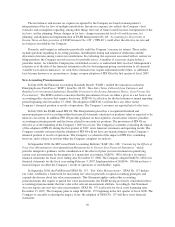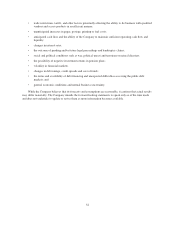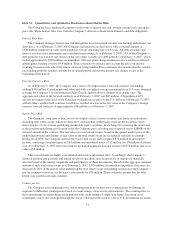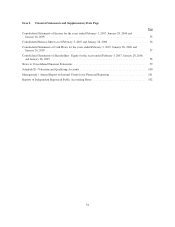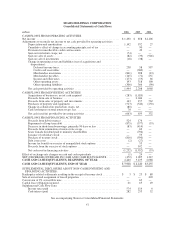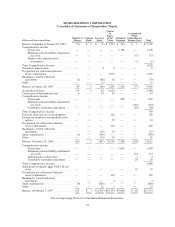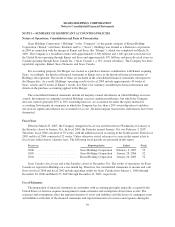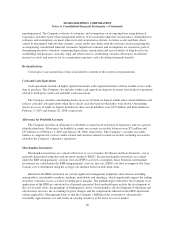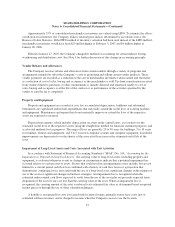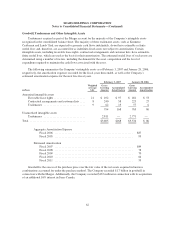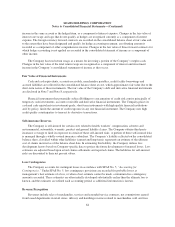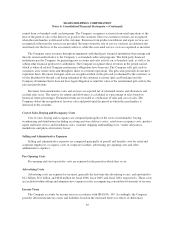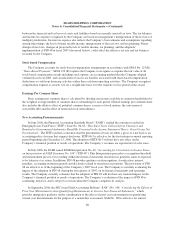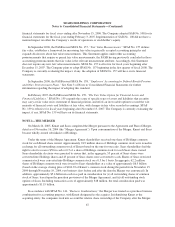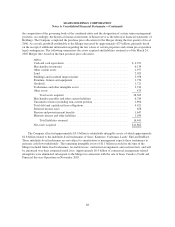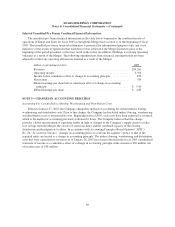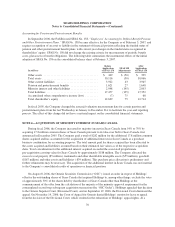Sears 2006 Annual Report Download - page 60
Download and view the complete annual report
Please find page 60 of the 2006 Sears annual report below. You can navigate through the pages in the report by either clicking on the pages listed below, or by using the keyword search tool below to find specific information within the annual report.SEARS HOLDINGS CORPORATION
Notes to Consolidated Financial Statements—(Continued)
reporting period. The Company evaluates its estimates and assumptions on an ongoing basis using historical
experience and other factors that management believes to be reasonable under the circumstances. Adjustments to
estimates and assumptions are made when facts and circumstances dictate. As future events and their effects
cannot be determined with absolute certainty, actual results may differ from the estimates used in preparing the
accompanying consolidated financial statements. Significant estimates and assumptions are required as part of
determining inventory valuation, estimating depreciation, amortization and recoverability of long-lived assets,
establishing self-insurance, warranty, legal and other reserves, establishing valuation allowances on deferred
income tax assets and reserves for tax examination exposures, and calculating retirement benefits.
Reclassifications
Certain prior year amounts have been reclassified to conform to the current year presentation.
Cash and Cash Equivalents
Cash equivalents include all highly liquid investments with original maturities of three months or less at the
date of purchase. The Company also includes within cash equivalents deposits in-transit from banks for payments
related to third-party credit card and debit card transactions.
The Company classifies outstanding checks in excess of funds on deposit within other current liabilities and
reduces cash and cash equivalents when these checks clear the bank on which they were drawn. Outstanding
checks in excess of funds on deposit included in other current liabilities were $353 million and $444 million at
February 3, 2007 and January 28, 2006, respectively.
Allowance for Doubtful Accounts
The Company provides an allowance for doubtful accounts based on historical experience and on a specific
identification basis. Allowances for doubtful accounts on accounts receivable balances were $29 million and
$35 million as of February 3, 2007 and January 28, 2006, respectively. The Company’s accounts receivable
balance is comprised of various vendor-related and customer-related accounts receivable, including receivables
related to the Company’s pharmacy operations.
Merchandise Inventories
Merchandise inventories are valued at the lower of cost or market. For Kmart and Sears Domestic, cost is
primarily determined using the retail inventory method (“RIM”). Kmart merchandise inventories are valued
under the RIM using primarily a first-in, first-out (FIFO) cost flow assumption. Sears Domestic merchandise
inventories are valued under the RIM using primarily a last-in, first-out (LIFO) cost flow assumption. For Sears
Canada, cost is determined using the average cost method, based on individual items.
Inherent in the RIM calculation are certain significant management judgments and estimates including,
among others, merchandise markons, markups, markdowns and shrinkage, which significantly impact the ending
inventory valuation at cost as well as resulting gross margins. The methodologies utilized by the Company in its
application of the RIM are consistent for all periods presented. Such methodologies include the development of
the cost-to-retail ratios, the groupings of homogenous classes of merchandise, the development of shrinkage and
obsolescence reserves, the accounting for price changes and the computations inherent in the LIFO adjustment
(where applicable). Management believes that the Company’s RIM provides an inventory valuation that
reasonably approximates cost and results in carrying inventory at the lower of cost or market.
60


